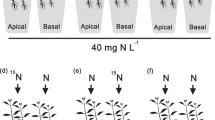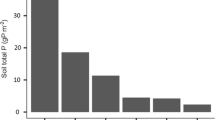Abstract
In order to examine whether the translocation of water and nitrogen in clonal plants is interdependent, interramet translocation of these two resources was investigated in the greenhouse. Two-ramet systems of Carex flacca were imposed to different spatial patterns of water and nitrogen supply. The experimental design allowed to examine the effects of water heterogeneity on nitrogen sharing, and, vice versa, the effects of nitrogen heterogeneity on water sharing. Interramet translocation of both water and nitrogen was quantified by stable isotope labelling. If one of the ramets was deprived of water, nitrogen or both resources (parallel resource heterogeneity), resource translocation towards this ramet was markedly enhanced compared to a control treatment in which both ramets received ample water and ample nitrogen. Under these conditions, the amount of water or nitrogen translocated was not significantly affected by the pattern of heterogeneity of the other resource imposed on the two-ramet system. If one of the interconnected ramets was rooted in dry but nitrogen-rich soil and the other ramet was placed in nitrogen-deficient but well-watered soil (reciprocal resource heterogeneity), a significant amount of water was translocated towards the ramet in dry soil, while the low-N ramet hardly received any nitrogen. These results show that little nitrogen is translocated between ramets in a direction opposite to the transpiration stream within the rhizome. However, nitrogen may be translocated independently from water if both are transported in a similar direction within the clonal system. The effects of translocation on ramet performance (in terms of transpiration, nitrogen accumulation, and biomass) were assessed by comparing interconnected ramets with isolated (severed) ramets that were treated identically. Integration enhanced the performance of ramets deficient of one or both of the resources. In case of water translocation, the transpiration and growth of the water exporting (donor) ramets was similar to the transpiration and growth of their isolated counterparts. When nitrogen was heterogeneously supplied, however, nitrogen accumulation and growth of the donor ramet was reduced to the same extent as the performance of the nitrogen-deficient ramet was increased. Water translocation thus enhanced the performance of the whole plant, while nitrogen only reduced the differences in ramet performance within the plant. In the case of the reciprocal heterogeneity treatment, the benefits of translocation were strongly unidirectional towards the ramet in dry soil. The data for this treatment suggested that total nitrogen accumulation was enhanced by the acquisition of nitrogen from the dry pot as a result of “hydraulic lift” and water exudation in the dry soil. We conclude that nitrogen translocation in clonal plants, and the associated benefits in terms of resource utilization and growth, may strongly depend on the pattern of interramet water transport. The implications are discussed for studies of physiological integration in clonal plants and the patterns of interramet resource sharing in the field.
Similar content being viewed by others
Author information
Authors and Affiliations
Additional information
Received: 2 November 1997 / Accepted: 9 April 1998
Rights and permissions
About this article
Cite this article
de Kroon, H., van der Zalm, E., van Rheenen, J. et al. The interaction between water and nitrogen translocation in a rhizomatous sedge (Carex flacca). Oecologia 116, 38–49 (1998). https://doi.org/10.1007/s004420050561
Issue Date:
DOI: https://doi.org/10.1007/s004420050561




